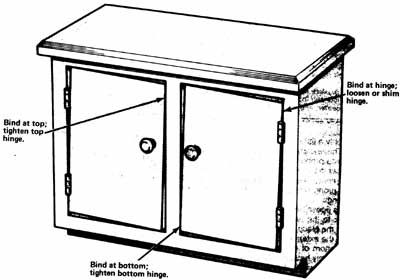Doors on wooden furniture, opened and closed on a regular basis, are bound to incur some sort of damage. Left unattended, that damage can spread to the structure of the entire piece. Some repairs are simple, while others may require the replacement of an entire panel.
Splits
Split doors, panels, cabinet backs, and other flat parts should be repaired with glue. Very thin door panels and cabinet backs cannot be repaired, and should be replaced. Where appearance is not important, as on the back of a door that's always left closed, metal mending plates can be used for reinforcement.
Sagging or Binding Doors
Sagging doors are usually caused by faulty hinge operation; the first thing is to check the hinges, no amount of work on the doors will be successful if they are not functioning properly. Binding doors can be again caused by faulty hinges or by excess humidity. Swelling from humidity or moisture vapor is most common in spring and summer and is most likely to affect wood that hasn't been properly sealed. In fall and winter, when the humidity is lower, the wood will shrink again.
Before work is done on the actual wood, the hinges are chacked for wear and adjusted. If the door binds at the top on the latch side, the top hinge is probably loose; the screws are tightened. If the door binds at the bottom on the latch side, the bottom hinge probably needs tightening. If the door binds on the hinge side, the hinges may be too tight or may be mortised too deeply into the wood. In this case, we remove the affected hinge or hinges and add a shim of thin cardboard under each one, then replace them.

If hinge adjustment doesn't work, we remove some wood at the binding points, being very careful in removing any wood; using sandpaper rather than a plane. To prevent future swelling, the raw edge is sealed with shellac when the weather -- and the wood -- is dry. Even in the workshop where it is obviously dry, they are not sealed if the humidity is high.
Replacing Door Panels
Many cabinets have flat door panels, either veneered or covered with cloth, cane, metal, or glass. Split panels should be replaced. If the covering of one panel is damaged, all panels should be recovered, if necessary, to match.
Door and drawer panels are usually held in place by molding strips nailed around the edges, sometimes surface-mounted and sometimes set into a rabbet-type joint. (The rabbet is a reinforced butt joint, with one or both joining members notched to fit together; it is usually reinforced with screws or nails.) These molding strips may be hard to see, but by carefully prying around the panel it is possible to see how they're attached.
To replace or recover a panel, the molding is removed using a butt chisel, a knife blade, being careful not to damage either the molding or the wood. After removing the molding on all four sides, the damaged panel is lifted out of the frame. Some raised door panels are fastened with screws from the back of the door frame; these screws must be removed before the panel can be taken out. Raised panel doors may be in one piece; in this case, the panel cannot be removed. To repair this type of door, the door must be removed from its hinges.
On very old furniture, door panels often require special repair techniques. If the panels are held by moldings, these moldings are removed very carefully, try not to bend or damage the nails that hold the moldings; it's best to reuse these nails when you replace the moldings. If the panel is held in the frame in grooves (dadoes), the best way to remove it is to soften the adhesive around the panel with heat or moisture -- a hot towel is a good tool. Most old furniture was put together with animal or fish glue, and this adhesive can usually be softened. If this doesn't work, the door will have to be taken completely apart or even cut apart and reassembled.
Panels set in square or rectangular frames are seldom really square. To cut a replacement for any panel, the old panel is used as a pattern. Replacement panels are never forced in or they may break the frame. If necessary, the panel is cut down to fit the frame.




 LOCATION
LOCATION
